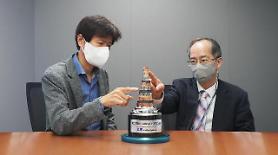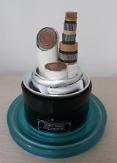
[Courtesy of KEPCO]
A ground-breaking ceremony chaired by Korea Electric Power Corp. (KEPCO) took place on June 24 in the northern border city of Paju to demonstrate the commercial operation of a platform for urban power supply using 23 kilovolts (kV) superconducting coaxial cables for completion in December 2023.
The project is to establish a superconducting station between two substations and supply electricity to nearby areas by connecting them with superconducting cables that remain below minus 200 degrees Celsius. After installing a small superconducting station, which is about one-tenth of an existing substation, power is supplied by connecting the outer substation through a 23kV underground coaxial cable.
Superconducting cable uses superconductivity where electric resistance becomes 0 at an extremely low temperature to transmit electric power. The direct current type will be used for underground cables for high-power transmission and high-capacity, long-distance transmission. Alternating current can be synchronized with electric power systems.
The superconducting platform reduces the size of substations and construction costs. "A successful demonstration project will enable eco-friendly power facilities without large-scale civil engineering work in the city center," KEPCO's power research center head Lee Jung-ho said in a statement.
The platform is aimed at building large-scale power facilities outside the city center and small superconducting platforms in the city center to connect them with superconducting cables.
KEPCO has tested the commercial operation of high-temperature superconducting (HTS) power cables In Shingal, 30km south of Seoul, to connect two substations with a 23 kV cable over a distance of one kilometer. As a next step, the company would apply HTS cables to enhance the power supply reliability of 154 kV radial substations.
For KEPCO's superconducting platform business, LS Cable & System, a major cable maker in South Korea, has developed a 23 kV superconducting coaxial cable that can transmit large amounts of power with little power losses during power transmission and generate no electromagnetic waves.
South Korea has designated ultra-high-pressure power cables as core national technology. In February 2022, LS C&S teamed up with the state-funded Korea Electrotechnology Research Institute (KERI) for joint research in high-voltage direct current transmission (HVDC) that converts alternating current into high-voltage DC. HVDC cables are more advantageous for long-distance transmission and have less loss than conventional AC transmission.
Copyright ⓒ Aju Press All rights reserved.



